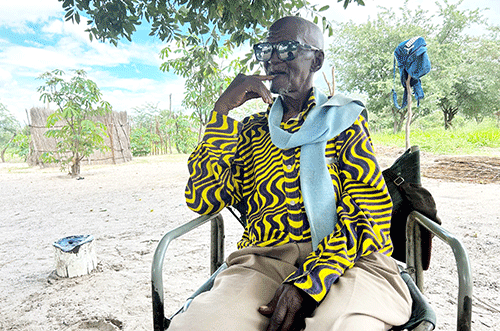BWABWATA- In the heart of Bwabwata National Park, the Khwe community faces an uphill battle for survival. Once reliant on their cattle for ploughing and farming, they now find themselves without oxen and without enough food to sustain their families.
Cabinet took a decision in 1999, prohibiting communities in the Bwabwata National Park area from owning cattle.
The Khwe feels the 1999 Cabinet decision did not provide them with any other alternative where to graze their cattle. The Khwe are a distinct ethnic group in the Kavango East and Zambezi regions. They are the descendants of the first people living in the area, but feel their status as a traditional community and indigenous people have been denied by the government.
At 95 years, Chetto headman Thikoko Djugwe has seen many seasons come and go, but one thing remains unchanged—the struggle of his people.
“I don’t remember seeing any government tractor in the longest time of my life,” Djugwe says. “We are not allowed to own cattle inside the park. Government removed our cattle when a decision was taken. If we had oxen, we could plough and produce food for ourselves to lessen the burden on the government.”
The restrictions on cattle ownership stem from concerns over foot and mouth disease. While other villages still have cattle, the Khwe in Chetto and Masamba were forced to give theirs up—leaving them to plough with hoes or, in a controversial move, donkeys.
“The government gave donkeys to the community for ploughing,” says Geriya Sonner, a local resident, shaking his head. “But a donkey doesn’t have the power to plough.”
Rain, but no harvest
This year, the land was blessed with good rains, offering a rare chance for a successful harvest. But without oxen or tractors, most Khwe farmers were unable to plough in time.
“If we still had our own cattle, we could plough on time and produce our own food,” Sonner explains.
“Government tractors come too late when the rain has already started. They should arrive in November so we can prepare the land.”
With few options, some farmers still attempt to plant using hoes, but their efforts are constantly under threat—not just from poor equipment, but from the wild animals that roam the park.
“Elephants and buffaloes destroy our maize crops,” Sonner adds. “So, even when we try to farm, we lose everything.”
The Khwe people depend on government drought relief food, but it is not enough to sustain them. Every three months, each household receives 10 kg of maize meal, a tin of fish and cooking oil, depending on how many people live in it—a ration that quickly runs out in households where unemployment and poverty are widespread.
Women, especially young girls, face additional struggles. Early pregnancies are common, and many men deny responsibility, leaving children unsupported.
Djugwe believes the government must do more to help. “We don’t even get seeds to plant,” he says. “People don’t have social grants because they are not registered.”
For now, the Khwe people remain trapped in a cycle of hardship—with no cattle to farm, no tractors to plough, and no reliable food supply. And as long as these challenges persist, they say their dream of self-sufficiency remains just that—a dream.


